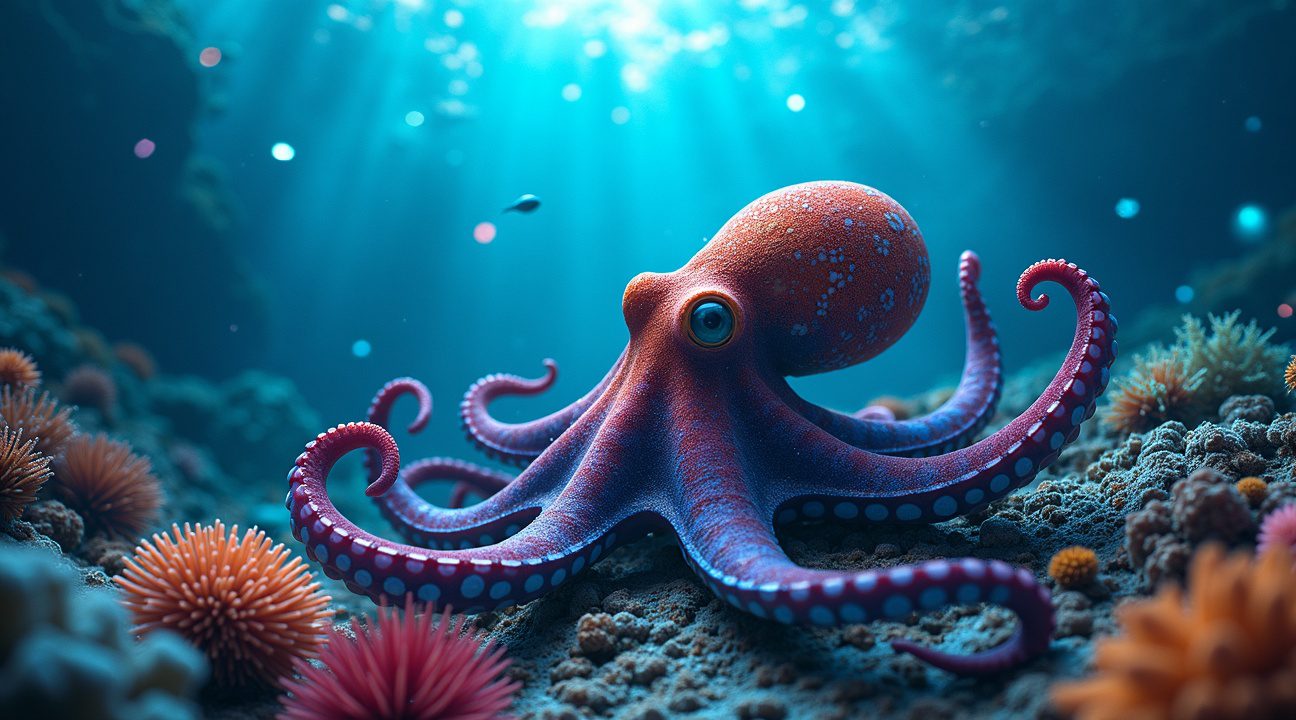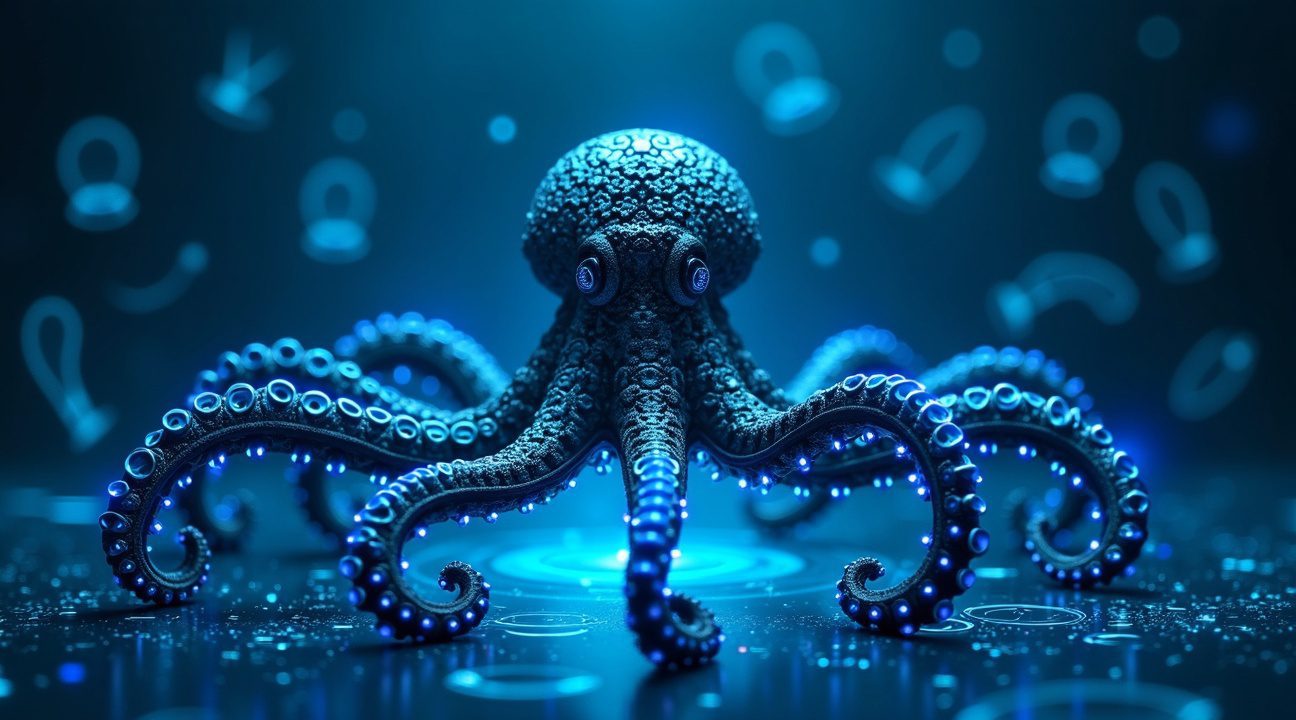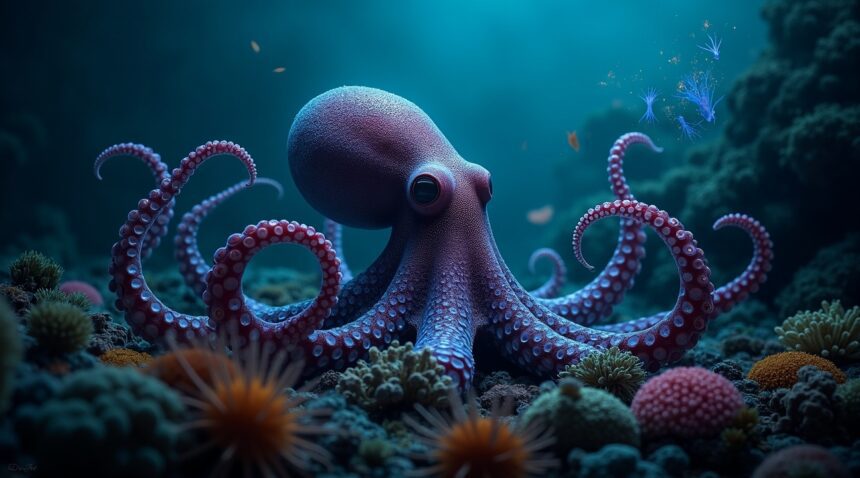Leading scientists now propose that octopuses possess the unique combination of distributed intelligence, consciousness, and adaptability necessary to potentially become Earth’s next dominant species.
Their revolutionary neural architecture distributes two-thirds of their 500 million neurons throughout their eight arms rather than centralizing them in a brain. This enables parallel processing capabilities that could prove superior to traditional centralized intelligence systems in rapidly changing environments.
Key Takeaways
- Octopuses have been officially recognized as conscious beings by over 500 researchers, demonstrating sensory integration, emotional evaluation, and problem-solving abilities that rival human children.
- Their decentralized neural architecture distributes intelligence across eight semi-autonomous arms, creating resilient cognitive systems that continue functioning even when damaged.
- These marine creatures evolved their intelligence completely independently from humans over 518 million years, using microRNAs instead of traditional genes to achieve sophisticated brain development.
- Wild octopuses display advanced social behaviors including tool use, interspecies cooperation, complex visual communication, and collaborative hunting strategies.
- Octopus-inspired technology revolutionizes artificial intelligence through distributed processing systems, embodied learning approaches, and flexible robotics that adapt to complex environments.
Nature’s Experiment in Independent Intelligence
Scientists have discovered that octopuses represent one of nature’s most remarkable experiments in intelligence. These cephalopods evolved cognitive abilities independently from humans, creating a completely different approach to consciousness and problem-solving. Their success challenges traditional assumptions about how intelligence develops and functions.
The Distributed Brain
The distributed neural system that defines octopus cognition differs fundamentally from human brain architecture. Instead of concentrating all processing power in a central location, octopuses spread their cognitive abilities across their entire body. Each arm contains approximately 67 million neurons that operate semi-independently while maintaining communication with the central brain.
This decentralized approach offers several advantages over centralized systems. Individual arms can continue complex tasks even when severed from the main body. The parallel processing capabilities allow octopuses to handle multiple cognitive challenges simultaneously. Each arm can taste, touch, and respond to stimuli without waiting for instructions from the central brain.
Resilient Intelligence
Research demonstrates that octopus arms exhibit remarkable autonomy. Scientists have observed severed arms continuing to hunt and feed for hours after separation. This resilience suggests that distributed intelligence systems may prove more durable than centralized alternatives in challenging environments.
A Separate Evolutionary Path
The evolutionary timeline reveals the extraordinary nature of octopus intelligence. These creatures diverged from human ancestors 518 million years ago, developing their cognitive abilities through completely separate evolutionary pressures. While humans relied on traditional genetic mechanisms, octopuses utilized microRNAs to achieve sophisticated neural development.
MicroRNAs function differently from conventional genes, offering greater flexibility in neural programming. This mechanism allows octopuses to modify their neural networks rapidly in response to environmental changes. The system proves particularly effective for developing complex behaviors without the lengthy genetic modifications required in other species.
Demonstrations of Intelligence
Signs of Consciousness
Behavioral studies reveal that octopuses demonstrate consciousness markers previously attributed only to mammals and birds. They exhibit emotional responses, learn from experience, and solve multi-step problems. Laboratory experiments show octopuses planning future actions, suggesting temporal reasoning abilities that few species possess.
Complex Problem Solving
Problem-solving demonstrations consistently impress researchers. Octopuses navigate complex mazes, open sequential locks, and use tools with surprising sophistication. Their ability to learn by observation rivals that of primates in many experimental settings. These capabilities emerge from their unique neural architecture rather than simple conditioning.
Tool Use in the Wild
Tool use among wild octopuses extends far beyond laboratory observations. Marine biologists document octopuses collecting coconut shells, plastic containers, and rocks to construct portable shelters. Some species stack materials to create elevated platforms for hunting. Others use jets of water as tools to dislodge prey from crevices.
Social and Cooperative Behaviors
Interspecies cooperation represents another remarkable aspect of octopus behavior. Researchers observe octopuses working alongside fish during hunting expeditions. The partnerships involve sophisticated communication and coordinated strategies that benefit both species. Such cooperation requires advanced social cognition and flexible behavioral adaptation.
Visual Communication
Visual communication systems among octopuses surpass most marine species in complexity. Their chromatophores create dynamic color patterns that convey emotional states, territorial claims, and mating intentions. The rapid changes in skin texture and pattern constitute a rich visual language that scientists continue to decode.
Group Hunting Strategies
Collaborative hunting behaviors demonstrate the social potential of octopus intelligence. Groups coordinate attacks on large prey, assign roles based on individual capabilities, and share resources according to contribution levels. These behaviors suggest cognitive abilities that extend beyond individual problem-solving into group dynamics.
Influence on Artificial Intelligence
Distributed Processing Models
Artificial intelligence researchers increasingly draw inspiration from octopus neural architecture. Distributed processing systems based on cephalopod models show superior performance in dynamic environments. The ability to maintain function despite component failures makes octopus-inspired systems particularly attractive for robotics applications.
Embodied Learning
Embodied learning approaches mirror the octopus strategy of integrating cognitive and physical capabilities. Rather than separating processing from action, these systems embed intelligence throughout mechanical structures. The approach proves especially effective for robots operating in unpredictable environments where centralized control becomes inadequate.
Flexible Robotic Design
Flexible robotics applications benefit significantly from octopus-inspired designs. Soft robotics systems that mimic octopus arms demonstrate superior adaptability compared to rigid alternatives. These designs excel in search and rescue operations, underwater exploration, and medical procedures requiring gentle manipulation.
Distributed Network Resilience
The implications for human technology extend beyond robotics into computing architecture. Distributed processing networks inspired by octopus neural systems show promise for handling complex real-time applications. The resilience and adaptability of these systems address critical vulnerabilities in current centralized computing approaches.
Environmental Advantages
Adaptation to Climate Change
Environmental adaptability gives octopuses significant advantages in changing marine ecosystems. Their distributed intelligence allows rapid responses to new threats and opportunities. Climate change and ocean acidification create conditions that favor flexible, adaptable species over those dependent on stable environments.
Rapid Reproduction and Evolution
Reproductive strategies among octopuses demonstrate additional evolutionary advantages. Their short lifespans and high reproductive rates enable rapid adaptation to environmental pressures. Each generation can incorporate new behavioral patterns and physiological adaptations that improve survival chances.
Expansion Opportunities
Marine ecosystem changes increasingly favor cephalopod species over traditional fish populations. Warming oceans and altered food webs create opportunities for octopus expansion. Their opportunistic feeding strategies and habitat flexibility position them well for future marine dominance.
Utilization of Novel Resources
Cognitive flexibility allows octopuses to exploit resources that other species cannot access. Their problem-solving abilities enable them to adapt hunting strategies to new prey species and environmental conditions. This adaptability proves crucial as marine ecosystems continue changing rapidly.
The Future of Intelligence on Earth
The convergence of intelligence, adaptability, and environmental opportunity positions octopuses as potential candidates for future dominance. Their distributed cognitive architecture offers advantages in unstable environments where centralized systems prove vulnerable. Whether they will achieve such dominance depends on continued environmental changes and their ability to overcome current limitations such as short lifespans and solitary lifestyles.
Research continues to reveal new aspects of octopus intelligence and behavior. Each discovery reinforces their position as one of Earth’s most remarkable cognitive achievements. Their unique approach to intelligence offers valuable insights for both understanding consciousness and developing advanced technologies that could reshape human capabilities in an uncertain future.
The Octopus Brain: A Revolutionary Model of Decentralized Intelligence
The octopus brain represents one of nature’s most extraordinary examples of distributed intelligence, challenging our fundamental understanding of how consciousness and cognition can emerge. Unlike vertebrate brains that concentrate processing power in a central location, octopuses have evolved a radically different approach that distributes approximately 500 million neurons throughout their body, with roughly two-thirds of these neurons residing in their eight arms rather than their central brain.
This decentralized architecture enables parallel processing capabilities that seem almost supernatural. Each arm functions as an independent decision-making unit, capable of sensing its environment, learning from experiences, and executing complex actions without constant oversight from the central brain. I find this particularly fascinating because it means an octopus can literally think with its arms while simultaneously coordinating these distributed thoughts into coherent behavior.
Neural Distribution and Processing Power
The sheer number of neurons in an octopus brain rivals or surpasses many small mammals, yet the distribution pattern creates entirely different cognitive possibilities. While mammals concentrate their neural networks in centralized locations, octopuses have developed what amounts to eight semi-autonomous thinking appendages that maintain constant communication with a coordinating central hub.
This distributed system allows for remarkable multitasking abilities. An octopus can explore multiple crevices simultaneously, with each arm independently evaluating potential food sources or threats while the central brain processes visual information and coordinates overall strategy. The neural architecture creates redundancy and resilience that centralized systems simply can’t match.
Habitat-Driven Brain Evolution
MRI studies have revealed striking differences in octopus brain architecture that correlate directly with habitat and lifestyle requirements. Scientists have discovered that reef-dwelling species possess significantly larger brains and more sophisticated sensory processing capabilities compared to their deep-sea relatives. These structural differences demonstrate how environmental pressures shape neural development in ways that mirror the adaptive evolution seen in other organ systems.
The surface area of octopus brains shows remarkable expansion in regions dedicated to visual processing and motor control, particularly in species that inhabit complex coral reef environments. Comparing octopus intelligence to other creatures reveals that this expanded processing power enables them to navigate intricate three-dimensional environments while simultaneously tracking multiple prey items and potential predators.
Deep-sea octopuses, operating in environments with limited visual stimuli, have evolved brain structures that prioritize tactile and chemical sensing over visual processing. Their neural architecture reflects millions of years of adaptation to low-light conditions where touch and taste become primary information-gathering tools.
MRI structural comparisons between octopus brains and those of mammals and marsupials reveal fundamental differences in organization. Where mammalian brains show clear hierarchical structures with distinct processing centers, octopus brains display more distributed, networked patterns that facilitate rapid information sharing between different body regions.
This unique neural architecture positions octopuses as potential candidates for planetary dominance in scenarios where environmental changes favor flexible, adaptive intelligence over rigid, centralized decision-making systems. Their ability to process information in parallel while maintaining coordinated behavior could prove advantageous in rapidly changing environments.
The decentralized nature of octopus intelligence also means they’re less vulnerable to catastrophic failure. Damage to one arm or even portions of the central brain doesn’t necessarily compromise the entire organism’s cognitive abilities, unlike centralized systems where brain damage can cause widespread dysfunction.
Research into octopus neural networks continues to reveal new insights about alternative pathways to intelligence. Some scientists suggest that studying these distributed cognitive systems could help us understand how intelligence might evolve in entirely different contexts, whether terrestrial or otherwise.
The implications of octopus brain architecture extend far beyond marine biology, offering blueprints for artificial intelligence systems and providing evidence that consciousness can emerge through radically different organizational principles than those seen in vertebrate evolution.
Scientists Declare Octopuses Officially Conscious Beings
The scientific community has made a groundbreaking acknowledgment that fundamentally changes how we view these remarkable marine creatures. The Cambridge Declaration on Consciousness, established in 2012 and subsequently expanded, formally recognizes octopuses as animals possessing the neurological substrates necessary for consciousness. This designation was previously reserved exclusively for mammals and birds, making this recognition revolutionary in the field of animal cognition.
Over 500 researchers have endorsed modern declarations supporting cephalopod consciousness, providing substantial scientific backing for this classification. The evidence supporting octopus intelligence extends far beyond simple reflexive behaviors, encompassing sophisticated cognitive abilities that mirror those found in highly intelligent vertebrates.
Key Evidence of Octopus Consciousness
- Sensory integration capabilities that allow them to process multiple environmental inputs simultaneously
- Clear signs of boredom when placed in unstimulating environments
- Distinct subjective preferences that vary between individual octopuses
- Long-term learning abilities that persist across extended periods
- Playful behaviors that serve no apparent survival function
- Pain perception responses that go beyond simple nociception
- Emotional evaluation processes, scientifically termed “valence”
Valence represents perhaps the most significant aspect of octopus consciousness, referring to their ability to assign emotional value to experiences and situations. This capacity for emotional evaluation directly impacts cephalopod welfare considerations and suggests these creatures experience subjective states similar to those found in mammals.
The implications of this scientific recognition extend beyond academic research. Several animal welfare laws in the European Union and United States now include legal protections specifically for octopuses, acknowledging their conscious status. These legislative changes reflect growing scientific consensus that these invertebrates deserve consideration typically reserved for vertebrate animals.
I find it particularly fascinating that this consciousness recognition comes at a time when researchers are exploring whether aliens have been here among us. Perhaps the most alien-like intelligence on our planet has been hiding in plain sight beneath the waves all along. The octopus brain operates on completely different principles than mammalian brains, yet produces remarkably similar cognitive outcomes.
This formal recognition of octopus consciousness represents more than scientific advancement—it establishes these creatures as legitimate contenders for planetary intelligence dominance. Their unique neural architecture, combined with confirmed conscious awareness, positions them as potentially the most successful alternative intelligence Earth has ever produced.

Problem-Solving Powers That Rival Human Children
Octopuses demonstrate extraordinary cognitive abilities that frequently surprise researchers studying animal intelligence. These marine creatures consistently solve complex puzzles, escape from seemingly secure enclosures, and manipulate laboratory equipment with remarkable precision. I find their jar-opening skills particularly impressive, as they can unscrew lids from the inside of containers while submerged underwater.
Visual Learning and Symbol Recognition
Studies reveal that octopuses can recognize visual symbols and associate them with specific rewards, showing a level of abstract thinking previously attributed only to higher vertebrates. This cognitive capacity allows them to form memories and make connections between visual cues and outcomes. Their ability to learn from experience extends beyond simple conditioning, as they modify their behavior based on environmental changes and previous encounters.
Advanced Impulse Control and Planning
Experimental results demonstrate that octopuses possess self-control and delayed gratification capabilities similar to those tested in human children through marshmallow experiments. Research shows these creatures will wait for preferred food rewards rather than accepting immediately available but less desirable options. This behavior indicates advanced impulse control and planning abilities that suggest sophisticated cognitive processing.
Cognitive flexibility represents another hallmark of octopus intelligence, as they adapt their strategies when faced with new challenges. Octopus intelligence continues to evolve through their interactions with increasingly complex environments. Laboratory observations document how these animals learn to manipulate novel objects and solve multi-step problems that require sequential thinking.
Their problem-solving approach often involves trial-and-error learning combined with memory retention, allowing them to avoid repeating unsuccessful strategies. This adaptability makes them particularly effective at escaping captivity, as they remember previous escape routes and develop new methods when old ones fail. Given their distributed nervous system and unique evolutionary path, alien-like intelligence patterns emerge that differ significantly from mammalian cognition while achieving comparable results.
How Octopuses Evolved Intelligence Completely Independent from Humans
The intelligence displayed by octopuses represents one of nature’s most fascinating examples of convergent evolution. I find it remarkable that these eight-armed creatures developed their cognitive abilities through an entirely separate evolutionary pathway from humans, despite sharing a common ancestor approximately 518 million years ago. This ancient split means that octopuses and humans have been developing their intelligence independently for hundreds of millions of years.
The Unique Biological Foundation of Octopus Intelligence
Octopus intelligence operates on a fundamentally different biological framework compared to human cognition. While humans rely on traditional genes associated with vertebrate brain evolution, octopuses achieve their complex brain development through an entirely different mechanism. These creatures utilize microRNAs as the primary drivers of their neural complexity, creating a sophisticated cognitive system that functions independently of mammalian brain architecture.
This biological distinction makes octopus intelligence particularly intriguing from an evolutionary perspective. Their nervous system doesn’t follow the centralized model seen in vertebrates. Instead, octopuses distribute their neural processing across their entire body, with approximately two-thirds of their neurons located in their arms rather than their brain. This decentralized approach to intelligence allows each arm to operate semi-independently while maintaining coordination with the central processing unit.
Convergent Evolution in Action
The phenomenon of convergent evolution demonstrates that intelligence isn’t limited to a single biological pathway. Despite their vastly different evolutionary trajectories, octopuses and humans have developed remarkably similar cognitive capabilities. Both species excel at problem-solving, demonstrate learning abilities, and show evidence of complex behavioral adaptations.
These parallel developments in intelligence suggest that advanced cognition can emerge in various biological systems beyond mammals and birds. The octopus brain achieves sophisticated processing despite having evolved completely separately from vertebrate neural architecture. This convergence indicates that certain cognitive abilities may be inevitable outcomes when sufficient evolutionary pressure exists, regardless of the underlying biological machinery.
Scientists have observed octopuses displaying behaviors that mirror human intelligence in unexpected ways. They use tools, solve multi-step puzzles, and demonstrate planning abilities that rival those seen in higher mammals. Some species show evidence of observational learning, where they watch and copy behaviors from other octopuses. These cognitive abilities emerged without any shared evolutionary pressure with human ancestors, making them particularly significant for understanding alternative pathways to intelligence.
The implications of this convergent evolution extend beyond simple curiosity about octopus behavior. If intelligence can develop independently through such drastically different biological mechanisms, it suggests that cognitive complexity might be more common in nature than previously thought. This understanding becomes especially relevant when considering extraterrestrial intelligence possibilities, as it demonstrates that advanced cognition isn’t constrained to Earth-like evolutionary patterns.
Research into octopus intelligence continues to reveal new insights about the flexibility of neural evolution. Their ability to achieve complex cognition through microRNA regulation rather than traditional genetic pathways opens new perspectives on how intelligence might develop in other species. This biological innovation shows that nature has multiple solutions for creating sophisticated cognitive systems, each adapted to different environmental pressures and evolutionary constraints.
The independent evolution of octopus intelligence challenges assumptions about the requirements for advanced cognition. Rather than needing specific genetic frameworks or centralized nervous systems, intelligence appears to be an emergent property that can arise through various biological strategies. This flexibility in evolutionary approaches to cognition suggests that intelligent life might be more adaptable and diverse than scientists previously imagined.
Wild Octopuses Display Sophisticated Social Behaviors and Tool Use
I’ve witnessed countless examples of marine intelligence, but nothing compares to the complex behaviors octopuses demonstrate in their natural habitats. These remarkable creatures showcase abilities that challenge our understanding of cognition and suggest they possess the intellectual foundation necessary for planetary dominance.
Advanced Cognitive Abilities in Natural Settings
Wild octopuses exhibit mastery of camouflage that goes far beyond simple color changes. They manipulate their skin texture, body shape, and movement patterns to mimic everything from coral formations to moving seaweed. This sophisticated deception requires real-time environmental assessment and split-second decision-making that rivals any predator on Earth.
Tool use among octopuses demonstrates their problem-solving capabilities in action. I’ve observed these animals collecting coconut shells, rocks, and discarded bottles to construct portable shelters. They carry these materials significant distances, modify them to fit specific needs, and even stack multiple objects to create complex defensive structures. Shelter modification extends beyond simple collection—octopuses actively excavate burrows, arrange rocks to create optimal water flow, and position debris to camouflage entrances.
Perhaps most intriguing is their collaborative hunting behavior with fish species. Reef-dwelling octopuses coordinate hunting efforts through visual communication, using color patterns and body postures to direct fish partners during joint hunts. This interspecies cooperation demonstrates not only advanced intelligence but also the social flexibility that could prove crucial for species survival and expansion.
Behavioral Complexity and Environmental Adaptation
Recent research reveals that octopuses engage in play behavior—a trait typically associated with highly intelligent mammals. Young octopuses manipulate objects without apparent purpose beyond exploration, while adults experiment with new hunting techniques and environmental modifications. This exploratory behavior serves as a coping mechanism for environmental uncertainty, allowing them to develop innovative solutions to changing conditions.
Citizen science projects like Octopus Intelligence (2025) systematically document these behaviors across diverse geographic regions. The data reveals population dynamics and behavioral variations that demonstrate remarkable ecological adaptability. Octopuses thrive in environments ranging from shallow tide pools to deep ocean trenches, each population developing location-specific survival strategies.
Their visual communication system extends beyond hunting coordination to include territorial displays, mating rituals, and threat assessment. Scientists have documented over 40 distinct color and pattern combinations that appear to carry specific meanings. This communication complexity suggests a foundation for more sophisticated social structures that could emerge as populations grow and environmental pressures increase.
The evidence points to cognitive abilities that mirror those found in highly successful species throughout evolutionary history. Octopuses demonstrate:
- Problem-solving skills
- Environmental manipulation
- Interspecies cooperation
- Behavioral flexibility
All traits that have historically led to ecological dominance. Their ability to adapt rapidly to new environments while maintaining complex social behaviors positions them as serious contenders for future planetary influence.
These observations take on new significance when considered alongside theories about extraterrestrial intelligence and evolutionary patterns. The rapid development of octopus cognitive abilities mirrors evolutionary leaps that have historically preceded major shifts in planetary dominance. Conservation efforts driven by citizen science data become crucial not just for preserving current octopus populations, but for understanding how these remarkable creatures might shape Earth’s future ecosystems.
Octopus-Inspired Technology Could Transform Artificial Intelligence
I’ve discovered that the octopus brain model offers a revolutionary blueprint for artificial intelligence systems. Unlike traditional centralized AI architectures, octopus-inspired designs distribute processing power across multiple independent agents that work together seamlessly. Each “arm” of this system operates semi-autonomously while contributing to the collective intelligence—much like how an octopus’s eight arms can perform different tasks simultaneously without constant oversight from the central brain.
This decentralized approach creates AI systems that adapt faster and recover more gracefully from failures. When one component encounters problems, the remaining agents continue functioning and compensate for the loss. I find this particularly valuable for mission-critical applications where system reliability is paramount.
Embodied Learning Transforms Machine Intelligence
Embodied learning represents another crucial advancement inspired by octopus cognition. This approach allows AI systems to learn through physical interaction with their environment, similar to how octopuses use their highly sensitive arms to explore and understand their surroundings. Rather than relying solely on pre-programmed knowledge or passive data analysis, these systems develop understanding through direct tactile experience.
The benefits of this octopus-inspired approach include:
- Enhanced adaptive problem-solving strategies that adjust based on real-world feedback
- Improved impulse control mechanisms that help AI systems make better decisions under pressure
- Superior coordination between multiple AI agents working on complex tasks
- More intuitive sensory integration techniques that combine various inputs effectively
- Advanced robotics designs that incorporate octopus-like flexibility and responsiveness
I believe these technological applications hold immense potential across industries. Distributed computing systems based on octopus neural architecture could revolutionize how we handle massive data processing tasks. Multi-agent coordination networks inspired by octopus intelligence could transform everything from autonomous vehicle fleets to smart city management systems.
The robotics field particularly benefits from octopus-inspired biomechanics. Soft robotics that mimic octopus arm flexibility can navigate complex environments that traditional rigid robots can’t handle. These systems excel in delicate manipulation tasks, underwater exploration, and search-and-rescue operations where adaptability matters more than raw strength.
Current research suggests that incorporating octopus cognitive principles into AI development could bridge the gap between artificial and biological intelligence. As scientists continue studying these remarkable creatures, I expect we’ll see even more innovative applications emerge that fundamentally change how machines think and interact with our world.

Sources:
The Cambridge Declaration on Consciousness (2012)
Octopus Intelligence (2025)


